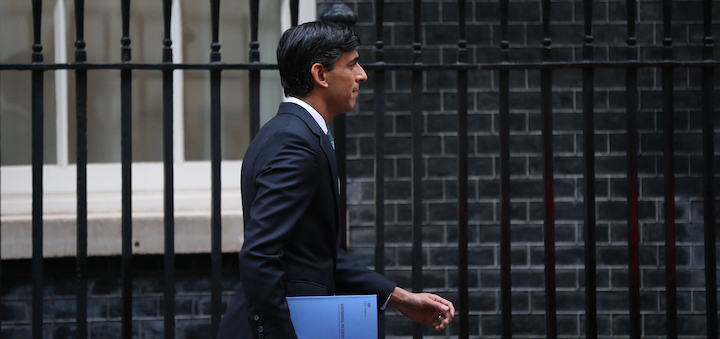Richard Harbord is reassured that the chancellor has a plan, though a little concerned that Rishi Sunak didn’t have one before today’s Spring Statement and that he retains faith in the unconvincing health and social care levy.
When there is a proper Budget, the Treasury background papers are normally around 1,000 pages. Somewhat disappointingly, I can only find 44 pages on the background to today’s Spring Statement.
There is a summary in chancellor Rishi Sunak’s speech. I will start with the macro-economic figures:
- The Office for Budget Responsibility (OBR) currently forecasts growth for this year at 3.8%. In the years 2023 to 2026, it will start at 2.1% and then settle around 1.7%.
- Unemployment is 3.9% (pre-pandemic levels) and will fall over the forecast period.
- Inflation was 6.2% in February. The OBR expects it to rise to 7.4% this year and reach 8.4% in 2023.
The chancellor also announced some immediate measures to help the cost of living.
- Five pence per litre has been cut from fuel tax. This starts from 6pm today. Unfortunately, on my way home to hear the Chancellor I filled my car with petrol. I could have saved £3 if I had waited.
- There is to be a saving on insulation, solar panels and heat pumps by removing VAT from them. Wind and water turbines are to be zero-rated as well
- The Household Support Fund is being doubled to £1bn and that will be down to local authorities to administer from April.
Underlying debt and government borrowing are forecast to fall over the next few years. However, in 2022/23 debt interest will cost the government £83bn. This is the highest on record and four times the previous year’s figure.
Sunak said that means that the government will have to “weigh carefully“ any calls for additional public spending.
Man with a plan
The big news in Sunak’s speech was that the government has a plan. One that reforms public services, grows the economy, levels up across the UK, helps families with the cost of living and cuts taxes.
Does that mean that up to now they haven’t had a plan? Anyway, it is very reassuring.
The tax element of the plan will lead to reform and reduction of taxes over this parliament.
The chancellor then said: “There is now a dedicated funding source for the country’s top priority – the NHS and social care. Providing funding over the long term, as demand grows. With every penny going straight to health and care.”
The big news in Sunak’s speech was that the government has a plan. Does that mean that up to now they haven’t had a plan? Anyway, it is very reassuring.
Less money for health and care?
So, the 1.25% health and social care levy, based on National Insurance Contributions (NIC), must stay. However, NIC thresholds will increase by £3,000, this year. (I may be wrong but that must mean less money for health and care.) Income tax thresholds rise to £12,570 from July 2022. Thus, saving taxpayers £330 per annum.
The other parts of the plan need careful thought and will be discussed over the summer and included in the Autumn Budget.
These include vocational qualifications and the apprenticeship levy to ensure businesses are incentivised to invest in the right kinds of training. R&D credits will be revised to incentivise innovation.
Sunak reminded the House that retail, hospitality and leisure businesses would get a 50% discount on business rates, and for small businesses the Employment Allowance will increase to £5,000 per annum.
I then turned to the detailed background information – the 44 pages I mentioned earlier. In summary:
- There is no change to Universal Credit, which was dealt with in February.
- Petrol duty cut is for 12 months.
- The basic rate of income tax will fall to 19% from April 2024.
- Wage growth was 4.8% in the three months to January 2022 and is expected to be 3.3% per annum from now until 2026.
- Despite low unemployment, there are 420,000 more inactive workers aged 16-64 in early 2022 against early 2020.
- There are 1.3m vacancies at present and 1.7m claimants in the Universal Credit “Searching for Work” group. The “Way to Work” campaign was aiming to move 500,000 into employment by June 2022.
Room151’s Monthly Online Treasury Briefing
March 25 2022
Online
Public sector delegates – register here
Inflation threat to local government
There is also a lot about inflation, but I think that this poses a real threat for local government budgets. We all know that the inflation experienced by local authorities has historically been higher than RPI or its equivalent. If evidence were needed, you only have to look at increases in costs in children’s and adult placements. Unless the promised reform of local finances moves apace, this is going to be difficult to manage.
There is a section on sustainable public finances. Public sector borrowing has fallen beyond OBR expectations, but it is still historically high. It will peak at 95.6% of GDP in 2021-22. But this increases debt interest payments.
I think that inflation poses a real threat for local government budgets. We all know that the inflation experienced by local authorities has historically been higher than RPI or its equivalent. Unless the promised reform of local finances moves apace, this is going to be difficult to manage.
Waste and inefficiency
The public spending targets from the 2021 Autumn Budget are reiterated. These show that departmental spending will grow by an extra £88bn a year in real terms by 2024-25.
To achieve this, the chancellor is to set up and chair a committee tackling waste and inefficiency across the public sector. This will include;
- Putting counter-fraud at the heart of decision making
- Investing £12m for HMRC to prevent error and fraud in tax credits.
- Publishing guidance for all arm’s length bodies
- Crowdsourcing ideas for innovation in Central Government
The second section of the statement deals with families and is summarised in Sunak’s speech; the third section sets out the cost of the Spring Statement and “previously announced measures”. I note in the table on page 27 that HMRC and DWP get over £1bn per annum for “investment in compliance”.
The fourth section is the tax plan which still needs work over the summer.
Local government’s levy lottery
All in all, there is not a lot in the speech or the background documents that will help local authorities. The implicit assumption – that the problems of social care funding will be solved by the levy – is misplaced and unconvincing.
We need a man with a more serious plan.
Richard Harbord is the former chief executive of Boston Borough Council.
—————
FREE weekly newsletters
Subscribe to Room151 Newsletters
Room151 LinkedIn Community
Join here
Monthly Online Treasury Briefing
Sign up here with a .gov.uk email address
Room151 Webinars
Visit the Room151 channel













